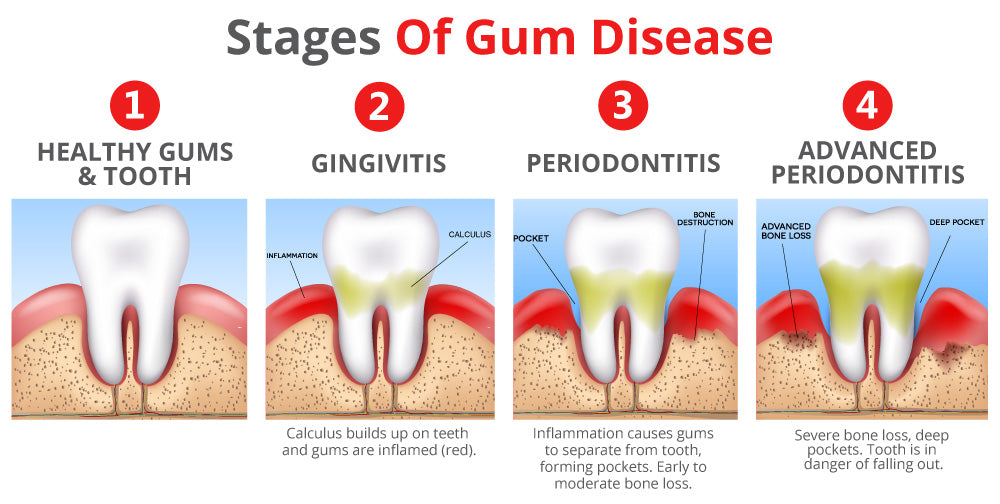Gum disease is an infection of the tissues that surround and support your teeth. It is a major cause of tooth loss in adults. Because early gum disease is usually painless, you may not know you have it. Also referred to as periodontal disease, gum disease is caused by plaque, the sticky film of bacteria that is constantly forming on our teeth.
Causes and Risk Factors
While plaque is considered the main cause of gum disease, other risk factors include:
- poor oral hygiene
- genetics
- smoking or chewing tobacco
- crooked teeth that are hard to keep clean
- pregnancy and hormonal changes
- diabetes
- some medications may increase the risk of developing gum disease.
Stages of Gum Disease
Depending on the severity and its progression, gum disease can be divided into gingivitis (1st stage), early periodontitis (2nd stage) and advanced periodontitis (3rd stage).
Gingivitis
Gingivitis is the first stage of gum disease and affects the soft tissue of the gums. Bacteria-laden plaque builds up along the gum line causing irritation of the gums. Gum becomes inflamed, may swell, redden and bleed quickly and easily while brushing the teeth. Although the symptoms may be very mild, it is important to diagnose gum disease in this early stage before it progresses to periodontitis.
Symptoms of gingivitis:
- Tender, red, sore, and bleeding gums
- Bad breath may or may not be present.
- Spaces between the gum and tooth (periodontal pockets) may exist due to the damage caused to the periodontal fibers that hold the gums tightly against the teeth.
- Plaque build up along your sensitive gum line is changed into a rough surface (calculus) on which more plaque accumulates.
- No underlying bone is involved or damaged
- This is relatively a mild form of gum disease and is easily reversible if treated early and properly
Periodontitis
As the gums become more inflamed, they start to pull away from the teeth, forming spaces known as periodontal "pockets." Food, bacteria, and plaque begin to collect in the pockets, leading to infection. The surrounding bone becomes damaged both by bacterial toxins and by the immune system's response to infection.
Symptoms of Periodontitis:
- Unlike the first stage, plaque (and / or calculus) is not found “along” but “below” the gum line.
- Bad breath is present.
- Tender, red, sore and bleeding gums may also be present.
- Periodontal pockets are formed as the dental tissues (gums and supportive ligaments) begin to pull away from the teeth. These pockets act as a trap for infection.
- Bone starts to show damage, often leading to loose permanent teeth.
- While relatively hard to treat, this stage can be reversed if addressed early and properly.
Advanced Periodontitis
Also known as severe periodontitis, this stage is a major cause of tooth loss in adults. It is characterized by bone damage, tooth decay and permanent tooth loss. Advanced periodontitis is marked by painful abscesses that are the result of the infection spreading beneath the gums.
Symptoms of Advanced Periodontitis:
- Periodontal pockets deepen and create more space for increased bacterial activity.
- Eventually the bones holding the teeth are damaged and destroyed, leading to tooth decay and loss.
- The deeper pockets may fill with pus. This pus exists between the teeth and gums and is more visible when the gums are pressed together.
- There may be swelling around the root which leads to even greater bone loss.
- Your bite is affected.
- Your permanent teeth may lose so much support that either they fall out or need to be removed forever.
- This third and final stage of gum disease is irreversible.
Conclusion
Gum disease is a common but serious issue that needs to be addressed early and treated properly. The earlier you treat gum disease, the easier it is to manage and the greater chance you have of restoring your oral health and saving your gums and teeth.
Even if you don’t notice any signs or clinical manifestations, you may still have some “silent or dormant” gum disease. Regular dental exams are the key for diagnosing the disease early and at a reversible stage.
Daily brushing, flossing and irrigating with the Hydro Floss can help you treat gum disease and keep it from progressing.
